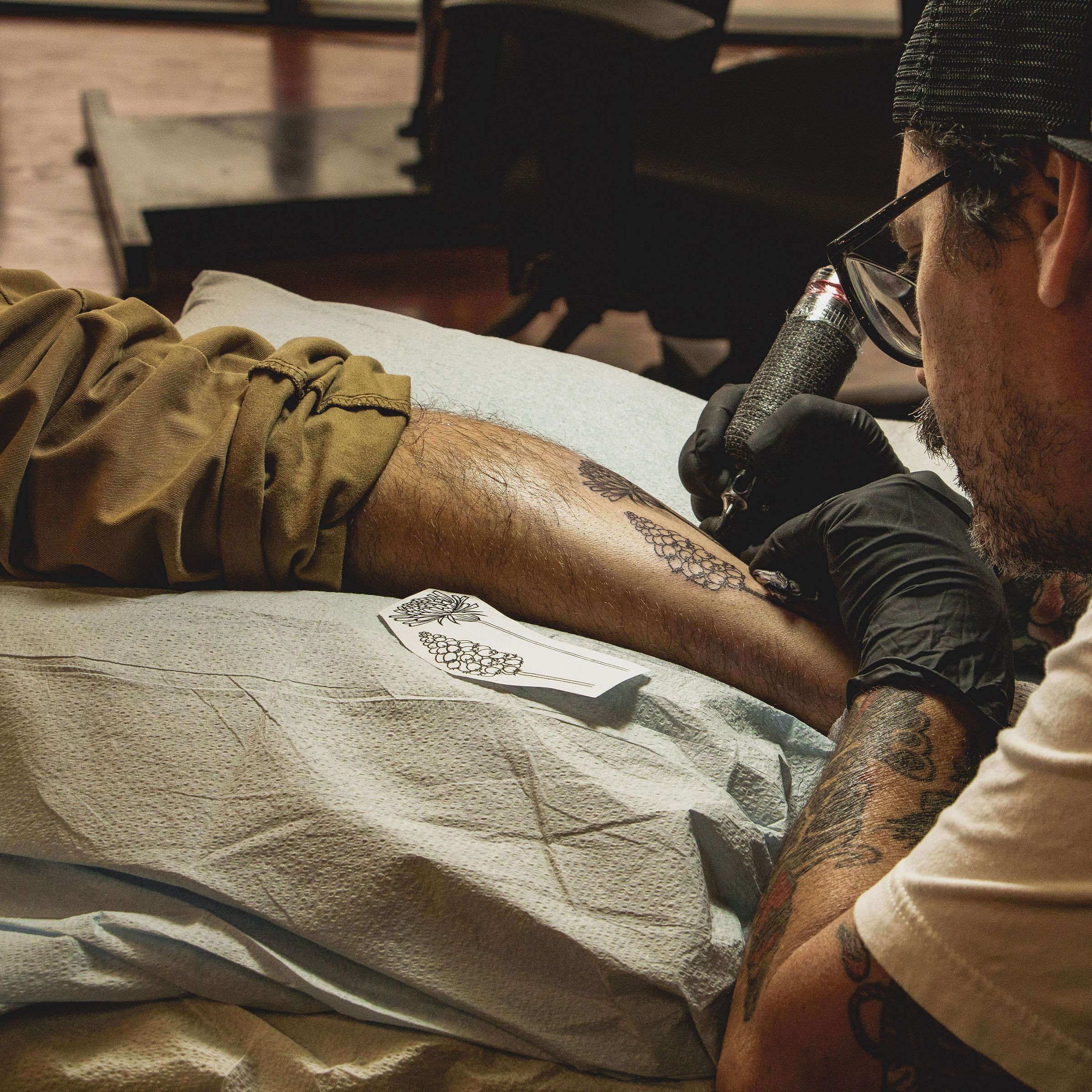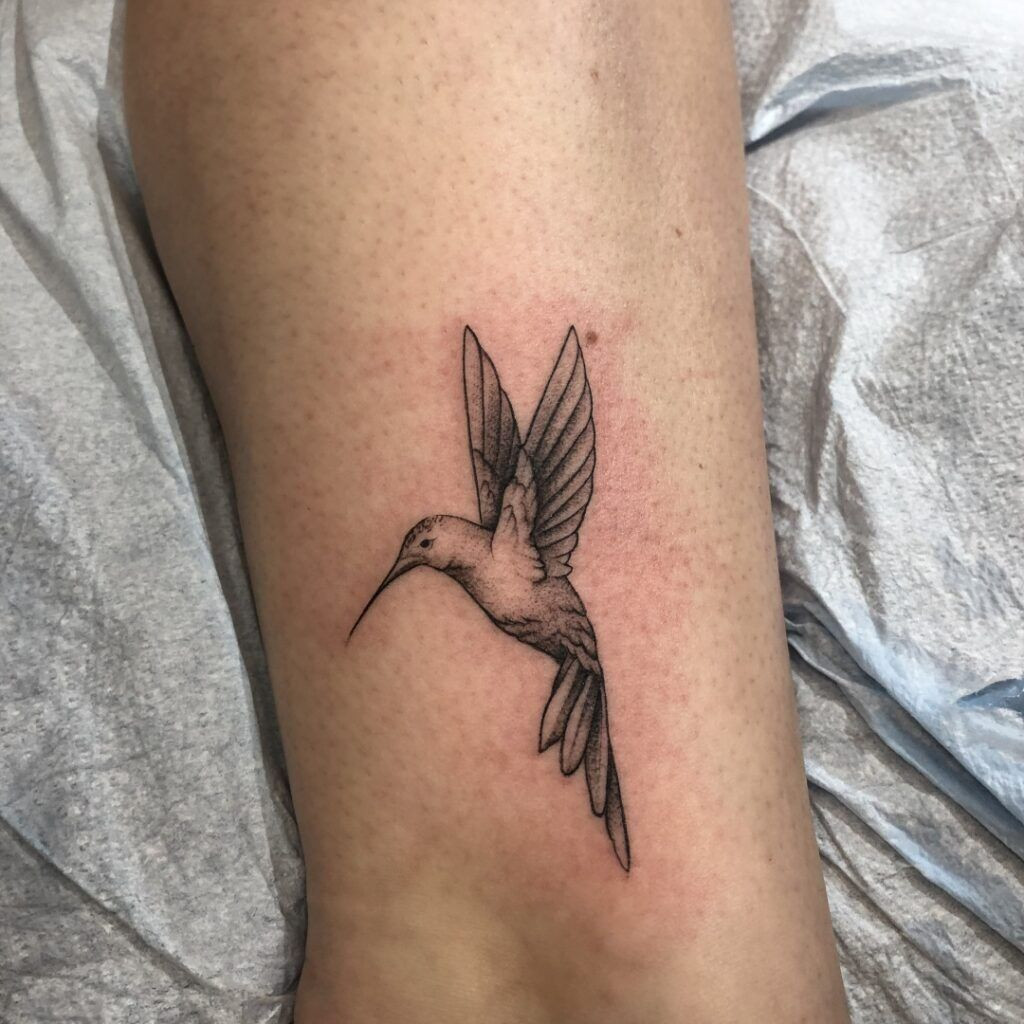Can You Bring Your Own Design To A Tattoo Parlor? Yes, bringing your own design to a tattoo parlor is absolutely an option that makes your experience more personal and unique. At tattooat.com, we encourage you to explore your creativity and collaborate with talented tattoo artists to create stunning, personalized body art. This guide explores the ins and outs of bringing your own design, ensuring a smooth and satisfying tattooing process. Dive into tattoo inspiration, custom tattoo, and tattoo appointment advice, all while understanding the importance of open communication with your tattoo artist.
1. Understanding the Role of Your Design in the Tattoo Process
Yes, you can bring your own design to a tattoo shop, and it acts as a starting point for your tattoo, offering inspiration and direction for the artist. Remember, it’s not about demanding an exact copy; instead, it’s about working together to create a unique piece that reflects your vision while respecting the artist’s expertise.
Your design provides a clear understanding of your desired outcome, allowing the artist to tailor it to your body’s contours and their artistic style. The tattooing process is a collaborative effort, where your initial idea evolves into a personalized work of art. Tattoo artists often adapt designs to ensure they translate well onto the skin, considering factors like size, placement, and longevity. According to Inked Magazine, successful tattoos result from a harmonious blend of your vision and the artist’s skill. Be open to suggestions, as the artist’s experience can enhance the design and ensure a beautiful, lasting tattoo.
2. Preparing Your Design for the Tattoo Parlor
Bringing a well-prepared design significantly enhances the consultation process and ensures clarity and precision in your tattoo. Follow these guidelines to make your design as effective as possible.
- Clarity and Detail: Present your design in a clear, high-quality format, whether printed or digital. High resolution images allow the artist to see the fine details and understand the intricacies of your vision.
- Multiple Angles: If your design has multiple elements or perspectives, provide different views to give the artist a comprehensive understanding.
- Color Palette: Clearly indicate your desired colors and shading. Providing color references or swatches can help the artist match the tones accurately.
- Size and Placement: Have a clear idea of the size and placement of the tattoo on your body. Use references or sketches to show the artist how you envision the final result.
By taking these steps, you provide the tattoo artist with a solid foundation, facilitating a smoother and more collaborative tattooing experience.
3. Why Tattoo Artists Might Adjust Your Design
While bringing your own design is encouraged, be prepared for potential adjustments by the tattoo artist. These adjustments aren’t meant to dismiss your ideas but rather to ensure the best possible outcome for your tattoo.
- Technical Limitations: Some designs may not translate well onto the skin due to technical limitations. Intricate details or fine lines can blur over time.
- Aesthetic Considerations: The artist might suggest changes to improve the overall aesthetic appeal and ensure the tattoo complements your body’s natural contours.
- Longevity: Adjustments may be necessary to ensure the tattoo remains vibrant and clear over the years.
- Artistic Style: Every artist has a unique style, and they might incorporate elements of their style to enhance the design while maintaining its essence.
According to research from Portland State University’s Art Department, in July 2025, collaboration between client and artist leads to higher satisfaction rates. Embrace the artist’s expertise and view their suggestions as enhancements to your original concept.
4. Communicating Effectively with Your Tattoo Artist
Open and honest communication is essential for a successful tattoo experience. Clearly articulating your vision, preferences, and concerns ensures that you and the artist are on the same page.
- Be Specific: Describe your design in detail, explaining the meaning behind it and any specific elements that are important to you.
- Ask Questions: Don’t hesitate to ask questions about the process, potential adjustments, or any concerns you might have.
- Listen Actively: Pay attention to the artist’s feedback and suggestions, and be open to their professional opinion.
- Provide Feedback: As the design evolves, provide constructive feedback to ensure the final result aligns with your expectations.
Effective communication fosters a collaborative environment, where your ideas are valued and the artist’s expertise is respected, leading to a tattoo that you’ll cherish for years to come.
5. Tattoo Etiquette: Respecting the Artist’s Expertise
Navigating tattoo etiquette is essential for a respectful and positive experience in a tattoo parlor. Understanding these unwritten rules ensures a harmonious interaction between you and the artist.
- Do Your Research: Before your appointment, research the artist’s style and expertise to ensure they are the right fit for your design.
- Be Respectful: Treat the artist and their workspace with respect. Arrive on time, be polite, and follow their instructions.
- Discuss Your Ideas: Clearly communicate your vision, but be open to the artist’s suggestions and adjustments.
- Don’t Haggle Over the Price: Tattoo pricing reflects the artist’s skill, time, and materials. Avoid haggling and respect their rates.
- Take Care of Your Tattoo: Follow the artist’s aftercare instructions diligently to ensure proper healing and longevity of your tattoo.
- Tip Appropriately: Tipping is customary in the tattoo industry. Show your appreciation by tipping 15-20% of the total cost.
By adhering to these guidelines, you create a respectful and collaborative environment, enhancing your overall tattoo experience.
6. What to Wear to Your Tattoo Appointment
Choosing the right attire for your tattoo appointment ensures your comfort and easy access to the area being tattooed.
- Accessibility: Wear clothing that allows easy access to the tattoo area. For an arm tattoo, a tank top or sleeveless shirt is ideal. For a leg tattoo, wear shorts or loose-fitting pants.
- Comfort: Opt for comfortable clothing, as you may be sitting for an extended period.
- Loose Fit: Avoid tight-fitting clothes that may restrict movement or irritate the tattooed area.
- Dark Colors: Choose dark colors to minimize the visibility of any ink stains that may occur during the process.
By considering these factors, you can ensure a comfortable and convenient tattoo session.
 what to wear to get a tattoo
what to wear to get a tattoo
7. Bringing a Friend: Support vs. Distraction
Bringing a friend to your tattoo appointment can provide support and ease anxiety, but it’s essential to consider the potential for distraction and overcrowding.
- Limited Space: Tattoo shops often have limited space, so bringing too many people can be disruptive.
- Privacy: Other clients may prefer a more private setting, so avoid turning your appointment into a social gathering.
- Distraction: Constant chatter can be distracting for the artist and yourself, so ensure your friend is mindful and respectful.
If you choose to bring a friend, ask the tattoo shop beforehand if it’s allowed, limit it to one person, and ensure they are supportive, quiet, and respectful of the environment.
8. Taking Breaks During Long Tattoo Sessions
Long tattoo sessions can be physically and mentally taxing, making breaks essential for your comfort and well-being.
- Communication: Inform your artist that you need a break, expressing it respectfully and understanding their need for concentration.
- Brevity: Keep breaks short and infrequent to minimize disruption to the artist’s work.
- Preparation: If you anticipate needing regular breaks due to health issues or pain tolerance, discuss this with the artist beforehand.
- Shop Protocol: Clarify the shop’s norms and protocols regarding breaks at the beginning of your session.
Remember, your comfort is part of the equation, and clear communication ensures a smooth and comfortable experience.
9. Requesting Design Changes: Timing and Etiquette
Asking for changes to your tattoo design is acceptable, but the timing and approach are crucial.
- Before the Session: The best time to request changes is before the tattooing begins. This allows the artist to make adjustments without disrupting the process.
- Smooth Revision Request: Articulate your needs with respect and patience. Ensure you’ve made a final decision about the design and are confident in it.
- During the Session: If changes are needed after the tattooing has started, express your concerns honestly and graciously. Minor adjustments may be possible, but significant alterations may require additional sessions or even a cover-up.
- Extra Costs: Realize that major changes may require extra work, which could incur additional costs.
Ultimately, clear communication and respect for the artist’s time and expertise are essential when requesting design changes.
 fine line hummingbird tattoo
fine line hummingbird tattoo
10. Music, Headphones, and Small Talk: Creating the Right Atmosphere
Creating the right atmosphere during your tattoo session can enhance your comfort and ease any anxiety.
- Music and Headphones: Many artists are open to you listening to music with headphones, as it can help you relax and pass the time. However, always ask for permission and keep the volume at a level where you can still hear the artist.
- Shop Music: Be mindful that many artists prefer to play their own music in the shop. While you can comment on the music, avoid asking them to change it.
- Small Talk: Some artists appreciate light banter to break up the day, while others prefer to focus on their work. Feel out the situation and respect their preferred style.
- Simple Topics: If small talk is welcomed, keep it light and positive, avoiding sensitive or controversial topics.
Remember, comfort is key, but it’s also important to respect the artist’s preferences and create a positive environment for everyone.
11. Snacks and Drinks: Staying Comfortable During Long Sessions
Bringing snacks and drinks to your tattoo appointment is generally acceptable, but there are guidelines to follow.
- Keep it Clean: Choose foods and drinks that are not messy or crumbly to avoid contaminating the tattoo area.
- Be Considerate: Avoid strong-smelling foods that may disturb the artist and other clients.
- Stay Hydrated: Bring a water bottle or sports drink to stay hydrated during long sessions.
- Ask First: Always ask the artist or shop if it’s okay to bring food and drinks before making any decisions.
Ultimately, communication and consideration are key to ensuring a comfortable and hygienic tattoo experience.
12. Negotiating Tattoo Prices: Is it Acceptable?
Negotiating the price of a tattoo is generally not considered good etiquette. Tattoo pricing reflects the artist’s experience, the complexity of the design, and the time it will take to complete.
- Discuss Your Budget: If the price is outside your budget, discuss it with the artist. They may suggest simplifying the design, reducing its size, or removing some colors to lower the cost.
- Avoid Haggling: Do not insult or offend the artist by unreasonably trying to undercut their rates.
- Save Up: If the price is well above your budget, consider saving up or choosing a smaller, simpler design.
Remember, a good tattoo is an investment in yourself, and it’s worth paying for quality and expertise.
13. Tipping Your Tattoo Artist: A Gesture of Appreciation
Tipping your tattoo artist is a customary practice and a gesture of appreciation for their skill and effort.
- Standard Percentage: The customary tipping rate is similar to that of a restaurant server, about 20 percent of the total cost.
- Gratitude: A tip is an affirmation of the artist’s talent and expertise, as well as their efforts to make your experience comfortable and enjoyable.
- Future Rapport: Tipping can enhance your rapport with the artist, potentially leading to better service in future appointments.
While tipping is at your discretion, it’s a thoughtful way to show your appreciation for the artist’s work and dedication.
14. Finding Inspiration and Artists at Tattooat.com
At tattooat.com, we’re dedicated to providing a wealth of resources to inspire your tattoo journey. Explore our extensive collection of designs, find talented artists, and learn essential information about the tattooing process.
- Design Inspiration: Discover diverse tattoo styles, themes, and placements to ignite your creativity.
- Artist Directory: Connect with skilled tattoo artists who can bring your vision to life.
- Informative Articles: Access detailed guides on tattoo aftercare, safety, and etiquette.
Visit tattooat.com today to start your exploration and create a tattoo that you’ll cherish forever. Our address is 1825 SW Broadway, Portland, OR 97201, United States. Phone: +1 (503) 725-3000.
FAQ: Bringing Your Own Tattoo Design
Here are some frequently asked questions about bringing your own tattoo design to a tattoo parlor:
- Can I bring a design I found online?
- Yes, you can use online images as inspiration, but be aware that the artist may need to modify it for technical or aesthetic reasons.
- What if I only have a vague idea of what I want?
- That’s perfectly fine. A good artist can help you refine your idea and create a custom design.
- Should I be worried if the artist wants to change my design?
- Not necessarily. The artist is likely trying to ensure the best possible outcome for your tattoo.
- Can I see a mock-up of the design before the tattooing begins?
- Yes, most artists will provide a stencil or digital mock-up for your approval.
- What if I don’t like the final design?
- Communicate your concerns to the artist, and they will work with you to make adjustments.
- Is it okay to bring multiple design ideas?
- Yes, bringing multiple ideas can help the artist understand your preferences.
- How much does a custom tattoo design cost?
- The cost varies depending on the complexity of the design and the artist’s rates.
- What if I want a tattoo in a specific style?
- Research artists who specialize in that style and bring examples of their work.
- Can I bring a friend to help me choose a design?
- Yes, but limit it to one friend to avoid overcrowding the shop.
- What if I change my mind about the design after the tattoo is started?
- It’s best to avoid this, as it can be difficult and costly to make changes.
Conclusion: Your Vision, Our Expertise
Bringing your own design to a tattoo parlor is an exciting way to personalize your body art. By understanding the tattoo process, communicating effectively with your artist, and respecting tattoo etiquette, you can ensure a smooth and satisfying experience. At tattooat.com, we’re here to support you every step of the way. Explore our resources, connect with talented artists, and bring your vision to life. Your dream tattoo awaits!
